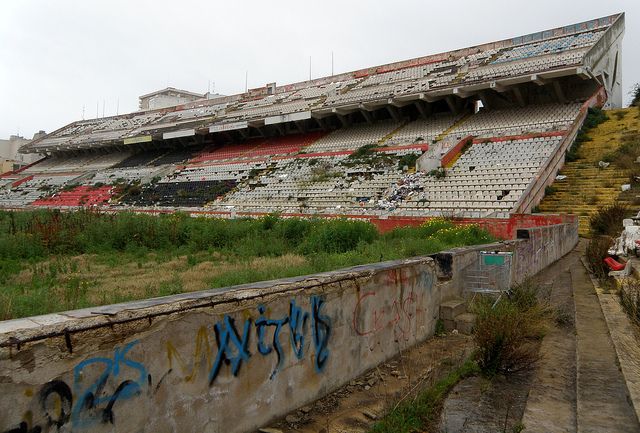Fiction: APA is so negative! You're opposed to all uses of the Park Lands!
Facts: We're not! We love to see people using the Park Lands. "Free and unrestricted access" for everyone is our goal. What we object to is
fencing to keep people out (other than for short-term 'events'),
privatisation and/or commercialisation; and
any buildings that aren't consistent with the character of the Park Lands as Open Green Public, i.e. a "a place for public recreation, leisure and enjoyment."
Read more here: MYTH #3 “Negative”
Fiction: You are NIMBYs who want to keep the Park Lands as your private back yard.
Fact: The truth is the exact opposite. Special interest groups or businesses are always seeking to build over Park Lands or fence out anyone who's not a paying customer or a members of their special group. APA is the voice of the public, seeking to keep the Park Lands Open Green Public - and free for all.
Read more here: MYTH #1: NIMBYs
Fiction: Any proposed new building should be supported because it will bring more people into the Park Lands
Fact: Proposed new private buildings will change the land on which they stand from being part of a Park, to being something else: a hotel, a school, an office, a restaurant; something other than a Park. A locked building by definition, is not Open Green Public.
We love to see people using the Park Lands but getting more people into them is not a goal in itself. Otherwise we might as well have all Parks looking like this:
Read more here: MYTH #5 “People”
Fiction: The Park Lands are under-utilised. There's no-one in them most of the time.
Fact: In 2014, the ADELAIDE City Council estimated that there were 8.87 million annual 'visitations' to the Parklands each year. This figure included:
1.87 million visits for informal recreation (e.g. running, cycling, picnicking)
1.75 million visits for organised sport; (e.g. soccer, football, cricket, netball, lacrosse, croquet and more)
1.68 million for "events" (e.g. Symphony Under The Stars, Writers Week and Soundwave Music Festival)
1.32 million visits to the Botanic Gardens, Botanic Park and West Terrace Cemetery; and
8,000 visitors for more than 100 weddings;
among other categories of visitations.
Read more here: MYTH #2: “Deserted”
Fiction: We need new buildings on Park Lands to help Adelaide come alive - to boost the city's vibrancy.
Fact: We agree that events on Park Lands boost tourism and add to Adelaide's appeal for residents and visitors alike. But non-stop "vibrancy" is impossible. Trends come and go. Once-popular pastimes and buildings eventually become stale, boring or irrelevant. That's why most events on Park Lands use temporary structures, such as marquees. If we erect buildings for currently-fashionable purposes, then the buildings will stay on for generations, with their footprint overlaying your Park Lands. If new buildings are really needed for "vibrancy" then they should be placed in City locations that won't effectively reduce your irreplaceable heritage of Park Lands.
Adelaide - You Need Vibrancy!
Estadio Lluís Sitjar, Mallorca (Spain) It used to be very "vibrant".
Read more here: MYTH #6 “Vibrancy”
Fiction: There’s plenty of Park Lands – look at all the open spaces. It doesn’t matter if just a little bit is built upon.
Facts: Approximately 25% of the land originally dedicated to your Open Green Public Adelaide Park Lands has been lost or “alienated” from the public since Colonel Light originally allocated 930 hectares. This includes 150 hectares that was lost almost immediately to 'Government Reserves' which brought your Park Lands back to about 780 hectares. Even if we disregard that initial loss, we have lost a further 80 hectares or so, over time, so that now, only around 700 hectares remain.
The loss of those 80 hectares since 1837 means that on average, you have been losing an average of 4,500 square metres annually. That's the size of about 7.6 tennis courts, on average, every year, Chipping away at the Park Lands occurs gradually, in small chunks; e.g. just a pathway, just a small fenced-off area, just an extension of a building, lost to a variety special interests. They all add up.
Egypt is selling off the pyramids! (?) !!
Fiction: You can’t call the sites of old buildings “Park Lands” any more. The old RAH site (now re-named as “Lot Fourteen”) is a great example of re-using space that was lost to the Park Lands in the mid-1800’s. Sites like this should not be classed as Park Lands because it has been more than 100 years since they were Parks.
Facts: This fiction is really saying that once a site is no longer Open Green Public it should never be returned to that status. However that is illogical. When an old building on Park Lands is no longer needed then the site can be, and should be returned to Park Lands. A great example is the former SA Water Depot which stood on Park 25 for 130 years but was eventually returned to Park Lands in 2012. Rymill Park once had a rubbish dump but the site was teturned to Park Lands in the 1960’s
When the new Royal Adelaide Hospital was opened in 2017, the old RAH site (the-so-called “Lot Fourteen”) could have been returned to Open Green Public Space just as the former SA Water depot was returned to the public in 2012. It is not only possible but the only appropriate thing to do with land which is recognised in law as Park Lands.
The site of the former SA Water depot which occupied the western part of Gladys Elphick Park / Narnungga (Park 25) for 130 years: now the Narnugga Urban Forest
Fiction: Car parking is a legitimate use of empty spaces in the Park Lands
Facts: Vehicle movements compact soil, and kill flora and fauna. Permitting car parking on Park Lands means there’s less incentive to develop public transport. It encourages disrespect for your Park Lands. Do you want a city in a park or a city in a carpark?
Read more here: MYTH #7: “Car Parking”
Fiction: When a building on the Park Lands is no longer needed it can be removed.
Facts: Of course it can be, but that very rarely occurs. Most buildings stay there, and new uses are found for them, or a new building takes the place of the old one. A lot of new buildings on North Terrace have taken the place of previous buildings that were on your Park Lands, so few people even realise that the land was ever Park Lands. It is a lot harder to get rid of something that is built than not to build it in the first place.
Fiction: So much of the Park Lands is degraded - dry, dusty not landscaped.
Facts: This fiction usually comes from those who have never visited (perhaps not even heard of) the Wirrarninthi environmental trail and wetlands (Park 23), the Walyu Yarta community garden (Park 21) the Himeji Gardens in Wita Wirra (Park 18) the wetlands in the southern part of Victoria Park (Park 16) etc. But of course, there are parts of your Park Lands that are not irrigated, and so the seasonal grass dries off in summer.
So what?
Adelaide City Council's Park Lands management strategy does not envisage every part of your Park Lands being landscaped like an English countryside. It would be prohibitively expensive to do that, and it would be nonsensical in the driest State in the driest continent to pretend that all vegetation stays verdant during heat waves. Whether they are lush and green, or dry and yellow (for some parts of the year) your Park Lands are large enough to effectively lower the temperature in the CBD (1) and also reduce electricity consumption in CBD buildings, especially those located close to your Park Lands (2). Seasonal dryness is no argument for limiting their size.
(1) Guan et al et al "Effective surface areas for optimal correlations between surface brightness and air temperatures in an urban environment" Journal of Applied Remote SensingVol. 9, 2015
(2) Guan et al "Response of office building electricity consumption to urban weather in Adelaide, South Australia" (2014) Urban Climate 10 (2014) pp 42-55
Read more here: MYTH #4: “Neglected”
Fiction: APA, you have no vision. We want Adelaide to come alive with new developments, and you are stuck in the 19th century. Why can't you envisage what the city could become?
Facts: We do have a vision. Here it is:
"In a crowded world with more and more people squeezed into megacities the world of the mid-21st century will come to prize and glorify the last remnants of open space that still survive in any of those vast urban concrete sprawls. In this over-crowded future, open space will be a rare jewel, and in that world, the city with the most abundant treasure trove will be Adelaide. Then, as now, Adelaide will still be the only city in the world surrounded by open Park Land. Tourists from all over the world accustomed only to tiny crowded parks (or no parks) in their home countries will come to revel and enjoy the untold riches that we (in our wisdom) would still have preserved, more than 200 years after the founding of our city. "
Some people want to make sure that this vision cannot occur because they are intent on building over or selling off Adelaide's priceless heritage, piece by piece.
Vijayawada, Andra Pradesh, India, 2014.
Park Lands? What are they?
Fiction: The Park Lands were intended to be a military buffer zone - to protect residents of Adelaide from an advancing 19th century army. This original purpose has long gone, so they should be developed.
Image: Shutterstock
Fact: This is simply a furphy. There is no evidence that Adelaide’s original surveyor, Colonel William Light, ever had this intention for the Park Lands. There is considerable evidence that the role of public open space was being favourably considered by social reformers in the UK at the time of colonisation, in the mid-1830’s. (3)
Even if, contrary to the evidence, the Park Lands were originally intended for this purpose, then that would be simply an historical anachronism. The value of the Adelaide Park Lands today rests not only upon the story of their beginnings, but on their world-unique status and value to South Australians today.
(3) Johnson, Donald (2013) “Anticipating Municipal Parks: London to Adelaide to Garden City (2013) Wakefield Press - Chapter 1 “Foundations”















